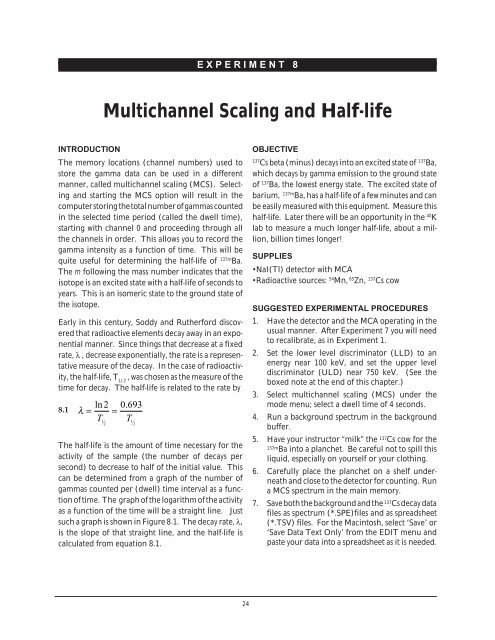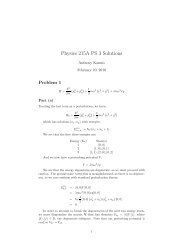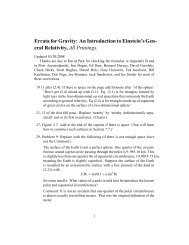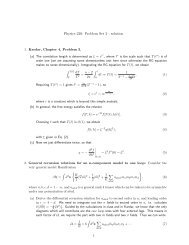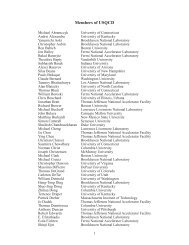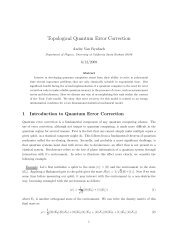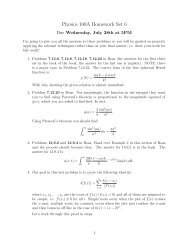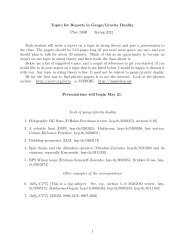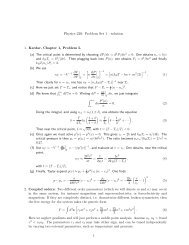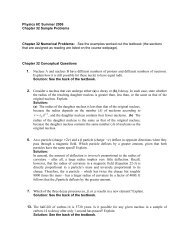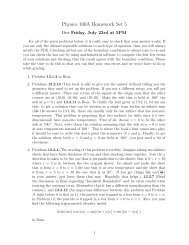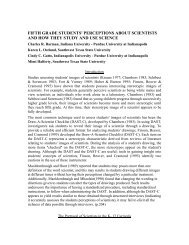Nuclear Spectroscopy
Nuclear Spectroscopy
Nuclear Spectroscopy
Create successful ePaper yourself
Turn your PDF publications into a flip-book with our unique Google optimized e-Paper software.
E X P E R I M E N T 8<br />
Multichannel Scaling and Half-life<br />
INTRODUCTION<br />
The memory locations (channel numbers) used to<br />
store the gamma data can be used in a different<br />
manner, called multichannel scaling (MCS). Selecting<br />
and starting the MCS option will result in the<br />
computer storing the total number of gammas counted<br />
in the selected time period (called the dwell time),<br />
starting with channel 0 and proceeding through all<br />
the channels in order. This allows you to record the<br />
gamma intensity as a function of time. This will be<br />
quite useful for determining the half-life of 137m Ba.<br />
The m following the mass number indicates that the<br />
isotope is an excited state with a half-life of seconds to<br />
years. This is an isomeric state to the ground state of<br />
the isotope.<br />
Early in this century, Soddy and Rutherford discovered<br />
that radioactive elements decay away in an exponential<br />
manner. Since things that decrease at a fixed<br />
rate, λ , decrease exponentially, the rate is a representative<br />
measure of the decay. In the case of radioactivity,<br />
the half-life, T 1/2<br />
, was chosen as the measure of the<br />
time for decay. The half-life is related to the rate by<br />
8.1<br />
ln 2 0.<br />
693<br />
λ = =<br />
T T<br />
1 2<br />
1 2<br />
The half-life is the amount of time necessary for the<br />
activity of the sample (the number of decays per<br />
second) to decrease to half of the initial value. This<br />
can be determined from a graph of the number of<br />
gammas counted per (dwell) time interval as a function<br />
of time. The graph of the logarithm of the activity<br />
as a function of the time will be a straight line. Just<br />
such a graph is shown in Figure 8.1. The decay rate, λ,<br />
is the slope of that straight line, and the half-life is<br />
calculated from equation 8.1.<br />
OBJECTIVE<br />
137<br />
Cs beta (minus) decays into an excited state of 137 Ba,<br />
which decays by gamma emission to the ground state<br />
of 137 Ba, the lowest energy state. The excited state of<br />
barium, 137m Ba, has a half-life of a few minutes and can<br />
be easily measured with this equipment. Measure this<br />
half-life. Later there will be an opportunity in the 40 K<br />
lab to measure a much longer half-life, about a million,<br />
billion times longer!<br />
SUPPLIES<br />
•NaI(Tl) detector with MCA<br />
•Radioactive sources: 54 Mn, 65 Zn, 137 Cs cow<br />
SUGGESTED EXPERIMENTAL PROCEDURES<br />
1. Have the detector and the MCA operating in the<br />
usual manner. After Experiment 7 you will need<br />
to recalibrate, as in Experiment 1.<br />
2. Set the lower level discriminator (LLD) to an<br />
energy near 100 keV, and set the upper level<br />
discriminator (ULD) near 750 keV. (See the<br />
boxed note at the end of this chapter.)<br />
3. Select multichannel scaling (MCS) under the<br />
mode menu; select a dwell time of 4 seconds.<br />
4. Run a background spectrum in the background<br />
buffer.<br />
5. Have your instructor “milk” the 137 Cs cow for the<br />
137m<br />
Ba into a planchet. Be careful not to spill this<br />
liquid, especially on yourself or your clothing.<br />
6. Carefully place the planchet on a shelf underneath<br />
and close to the detector for counting. Run<br />
a MCS spectrum in the main memory.<br />
7. Save both the background and the 137 Cs decay data<br />
files as spectrum (*.SPE)files and as spreadsheet<br />
(*.TSV) files. For the Macintosh, select ‘Save’ or<br />
‘Save Data Text Only’ from the EDIT menu and<br />
paste your data into a spreadsheet as it is needed.<br />
24


